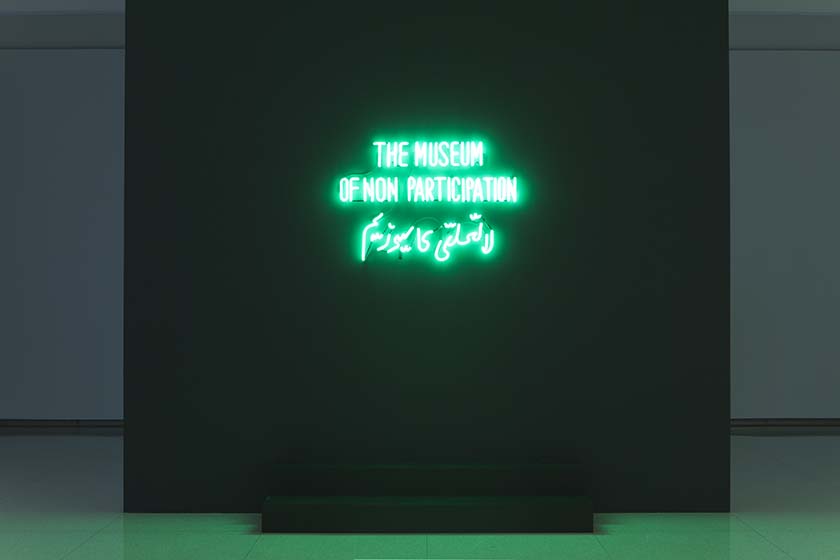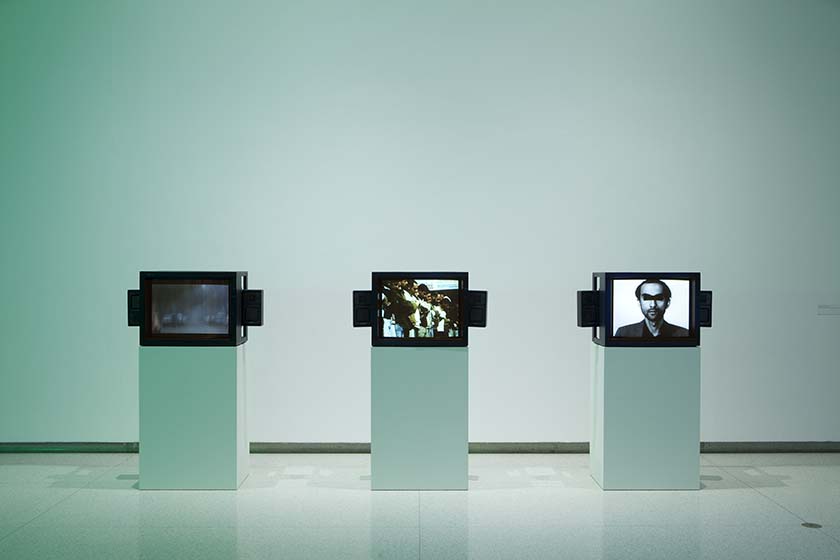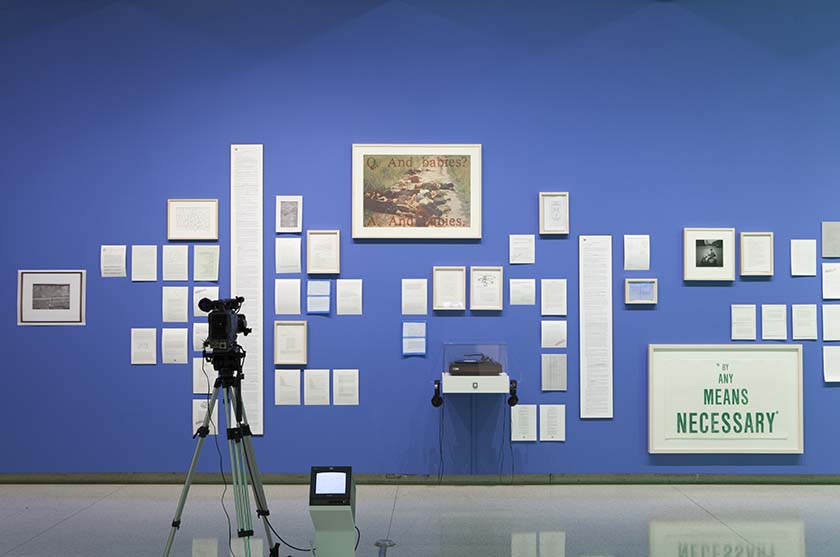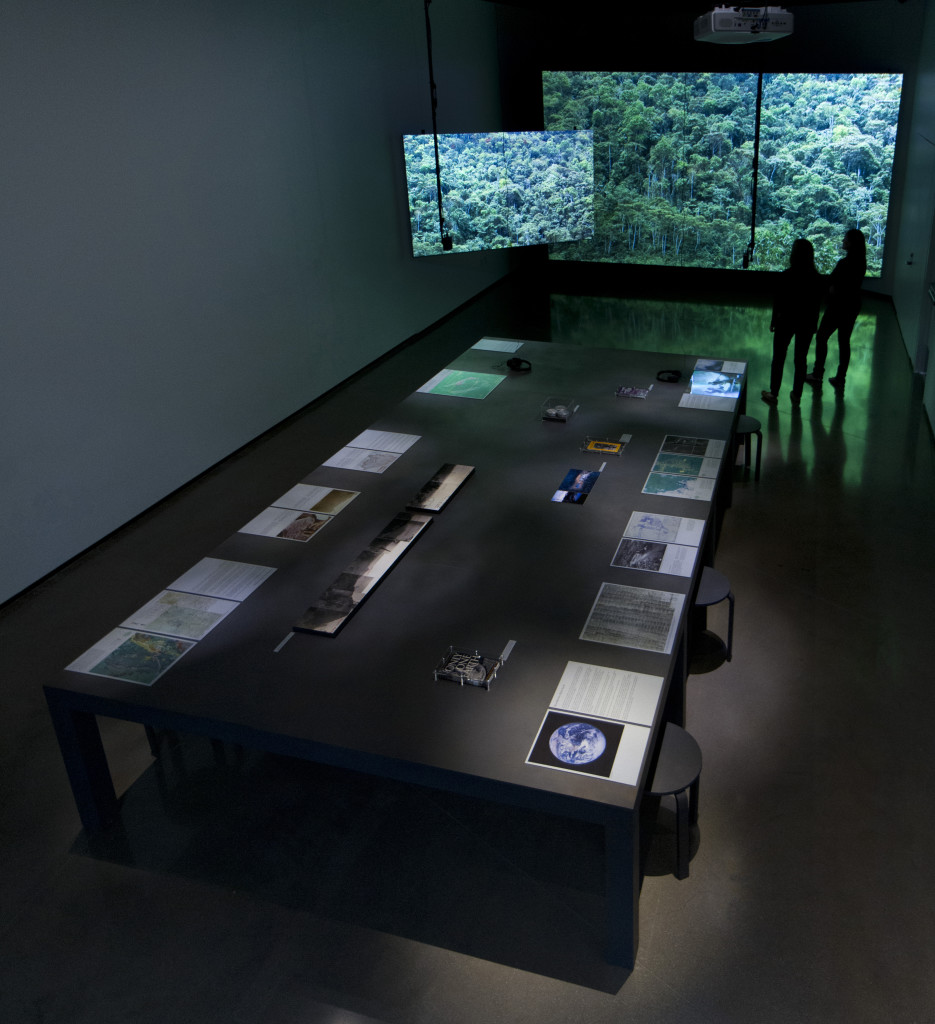
Yesomi Umolu is a Lagos-born, London-raised, Chicago-based curator with a mind for the global. Before holding curatorial positions at the Walker Art Center, the Eli and Edythe Broad Art Museum at Michigan State University, and the Logan Center for the Arts at the University of Chicago, Umolu studied architecture and curatorial studies in the UK. Her sensitivity to a space’s ability to craft narrative has been demonstrated in numerous exhibitions, where film and video works are often put to particularly innovative use. I spoke with Umolu after viewing her latest exhibition at the Broad MSU —a survey of contemporary art from West Africa and the diaspora entitled Material Effects.
GAN UYEDA: One of the things that I found most striking about Material Effects at the Broad was how, curatorially, the viewer was engaged through so many different senses. There was the cacophonous sound from Ibrahim Mahama’s piece at a distance, and as you approached it, there was a real smell to it. In this way, the viewer moved in and out of different aural spaces and through major shifts in visual scale. The building itself is also so weird, and must have presented some challenges to conceptualizing the floor plan—bearing all of this in mind, how did you approach the layout of the show?
YESOMI UMOLU: The show tells a story in some ways. It starts with the Senegalese artist Issa Samb, who was sort of the inspiration behind the show happening in the way that it did. With a view to creating a show that reflected on contemporary practices in West Africa and across the diaspora, I had done studio visits in Nigeria, Ghana, and Senegal, and met with probably thirty to forty different artists. At the end of my trip, I spent a lot of time in Issa Samb’s courtyard studio in Dakar, which is a really historic space. Eventually I came across this piece, a video interview that Antje Majewski had done with him, which I thought was a really beautiful portrait of him as a quite revolutionary thinker and maker. I started to recognize some of the things he was saying around objects and their status, particularly in a West African context, in some of the works I had seen during my visit. It was a parallel track to see the role Samb’s work plays in West African art history, and at the same time, thinking about the younger artists who have emerged in the last five to ten years that I thought were picking up some of that lineage. There was a sensibility [among these younger artists] that I felt matched what Samb was doing and thinking about.

So, the exhibition has a clear narrative. We begin with Samb —the conceptual backbone that continues throughout the show—and you move on to different artworks that build on the remarks and the insights that he has made. I started to think about Mahama as being the other side of the coin—where Samb is completely anti-capital and highly inspired by Marxist philosophy, Mahama is from a younger generation who is interested in interrogating capital and how it flows. Mahama is less interested in transgressing this fully, but instead concerns himself with deconstructing it. He provided a contrast to Samb, who was steadfast that objects took on completely different values of their own outside of the Western capitalist framework, and would work to undercut any sort of impressions of that framework in how he made his sculptural objects. That is how I see the distinction between the two.
Samb sought revolution, finding another path—with the younger generation, it is about understanding the systems that are already in place. I always thought of Samb and Mahama as a sort of pair—in a generational sense, a perspectival sense—they are both dealing with sculpture in a similar manner in terms of how their work appropriates everyday objects. Samb is very subtle and makes small sculptural gestures that for him translate the inherent energies of objects, whereas Mahama tends to work with monumental scale, crafting works that interrogate the circulation of objects in the world.
GU: The video interview of Samb by Antje Majewski at the beginning of the exhibition reads as a kind of thesis statement to the project. What is also interesting to me is that it is another artist’s interview of Samb—in this sense, you chose to include his words rather than his artwork. Do you see this as a way of tracking influence, of looking at Samb’s impact on discourse?
YU: Happening upon that video was serendipitous. From the beginning, I wanted to include some of Samb’s works in the show, and it just did not transpire in the timeframe we had. His practice is very contextual—so, it would not have made sense to transplant the objects in his courtyard to the gallery space without him somehow being involved in that process. That eventually did not seem like it was going to happen, but I knew I wanted to include his voice in some way. I happened upon Antje’s piece, and I actually think it worked out better because there is something important about understanding the man and the context he works in through his reflections. Samb would never think of himself as an artist, per se, as he works with very open-ended gestures—he really collapses the distance between art and life. It makes sense then that viewers experience it through his conceptual frame, as a opposed to inserting some of his objects that become reified in a way they do not exist as within his broader sculpture and performance-based practice.
GU: I would like to ask more about your background. You were born in Lagos, and partially grew up there and in the UK. Were you always interested in art?
YU: I moved to London when I was ten. My mom was an English teacher and my dad was a civil servant. My family was one of those families who always had close ties to Europe, my mom was actually born in England and spent a lot of time there during her childhood, and my dad studied in Europe during his formative years. They were children of the 1970s, an era in which post independence Nigeria was having an economic and cultural renaissance; this afforded them a lot of mobility. As a result of this, we had a very global sense of the world.
I had actually always wanted to be an architect—I studied architecture and went to architecture school, as well as working in practice for a couple of years. Then it dawned on me that I was not really good at making things, which is really rather important in architecture—to have a very technical mind and the desire to make objects in the world. But I was interested in the discourse and social relations that the built environment generates. At the time I was studying in the UK, there was a lot of funding and support for new research in the arts and humanities. A lot of architects were going to work in museums and in other cultural spaces, to use their skills and expertise, though not necessarily applying it towards building buildings. So, I was very interested in how you could practice as an architect, how can you craft space, without making anything.

GU: So you began the curatorial studies program at the Royal College of Art. What did you learn there? What did you take away in terms of how you approach exhibition making?
YU: Exactly. I studied under folks who were geared toward questions around post-colonialism and globalization, Mark Nash and Jean Fisher. When I was in architecture, I had written a lot around migrant spaces, and how as someone coming from elsewhere, you make your space differently. I was interested in how space articulates power relations and difference, whether cultural, social or economic. I really enjoyed that approach because it articulated my place in the world. It was great to work with Nash and Fisher because they filled in how artists and curators were dealing with questions of migration and belonging as they transitioned between different cultural contexts. Thinking in this framework was very useful.
GU: Apart from how transnational both your background and your exhibition history has been, a dominant theme throughout your practice is the use of moving image—specifically, video and film—and working through different ways of presenting the moving image in the gallery space. Is your transnational approach linked to the use of moving image?
YU: Yes—I think so. If you are dealing with questions of how one creates narratives through different spaces, then the moving image is ripe as a site; a space that can embody a psychology of movement, displacement, and disjunction, but also tell narrative through that process—however fragmented the narrative is! I find that the moving image seems to speak very truthfully about the themes I am interested in working with. This has been a recent realization of mine, having worked in different ways with artists, but also how the moving image relates to a kind of spatial politics and a critique of place. They marry in the same way.
But I also think it is something I am trying to figure out. I do not have one of those CVs where I am an expert in contemporary art from a given geographic area or have medium-specific concerns. I am drawn to a slightly more expansive notion of how you develop expertise in curatorial practice. I see myself as a very eclectic curator—I am trying to figure out if that is a good thing or not. We still live in a world where people have to lay claim to certain bodies of knowledge, and in many ways, that is how you get validated as you move through the world. Perhaps I have a post-colonial, I-don’t-want-to-lay-claim-to-anything outlook. But I want to be a good curator who supports artists first and foremost, and I want to work in progressive ways and support innovative ideas. For me, if I were to lay claim to anything, this is what I would lay claim to.
GU: Looking at even just the past few years, seeing exhibitions like the ones with John Akomfrah, Ursula Biemann, Karen Mirza and Brad Butler—all of these are with artists that are using not just film and video, but specifically a para-documentary approach. The documentaries that these artists are putting together are mining the archive, re-cutting, and re-editing historical material. Why do you think that is a recurring form?
YU: I am very interested in the contemporary; I am interested in what is happening now. So, while these artists are using the archive, they are also interested in contemporary social politics. That is where I think the documentary form comes in, because all these folks bear witness to the present in very interesting ways. That has been the case in Akomfrah’s work since he started in the late 1970s, in that he has never removed his work from the politics of what was going on around him. Similarly with Ursula and Brad and Karen, right? It is an understanding that in bearing witness to the present, you have to understand the past. The world that we live in is made through a series of modernizations, a series of progressions. You have to understand how we got here to really understand what here is.
As I mentioned earlier, my dad was a civil servant—so perhaps I watched too many newsreels, or too many political documentaries, but I am really interested in the world we live in now, and how artists are responding to that. How can [artists] be a kind of bridge to help us find solutions, or help us find different ways of interpreting the world we live in? I think it has to do with how we bear witness to the present.

GU: When you think about presenting a video, what are some of the considerations you put towards the gallery space? It is interesting to think about your architectural background informing this.
YU: It is always hard, because—especially when you are working with people who were trained as filmmakers—the compulsion is, “I just want this to be a black box.”
GU: And that’s something that you rarely do.
YU: Yes, I rarely do that. We have to contend with the gallery space—but it also does not mean that I am not open to having those conversations with filmmakers who are transitioning into an art space about what it means to present their film. With Akomfrah’s show, we definitely thought about the gallery space and considered what the narrative was that we were trying to tie together—how does it remain open and permeable? While you do want to stay true to the artist’s vision for the work, not every space can be a hermetically sealed black box (if only that could happen!). I like liveliness and duration in my exhibitions. Maybe that is another reason for the number of narrative and film works I have shown.
Exhibitions provide a different context than a black box; they require us to think about the space as a space that can be inhabited—as an architecture, in some ways—and from there, we have to create an architecture that defines the way we move around it, defines how we feel around it, our senses.
GU: Your first show here at the Logan—So-called Utopias—opened last fall. What is next?
YU: Monika [Szewczyk — former curator at the Logan Center for the Arts] was great, because she had a unique approach to her curatorial practice that came through in the projects in the gallery. It was super eclectic, open and collaborative, and I like that about the program she established for the gallery. For me, the aim here is to re-orient the program, and focus a bit more on what can we offer to artists when they come to work with us. What we can offer are the incredible resources in this building—from black boxes to theater spaces to screening rooms—in addition to a genuine interest in supporting them through the production of their exhibitions. Because of this approach, we will have two solo shows a year—each will be with emerging artists working in interdisciplinary ways and will focus on showcasing new commissions. The two artists that will launch the program are a London-based artist, Larry Achiampong—who is dealing with cross-cultural and post-digital identities—and Kapwani Kiwanga, a Paris-based Canadian artist. I have had a long interest in ethnography and how it perverts the work we do as artists and museum professionals. Kiwanga is trained as a social scientist and draws a lot in her practice from anthropology. The goal with the program I am laying out is to be responsive to new voices and our immediate context. Because of that, I am thus infinitely fascinated with the history of the South Side of Chicago, and cultural production here and finding ways to support that in the long term.